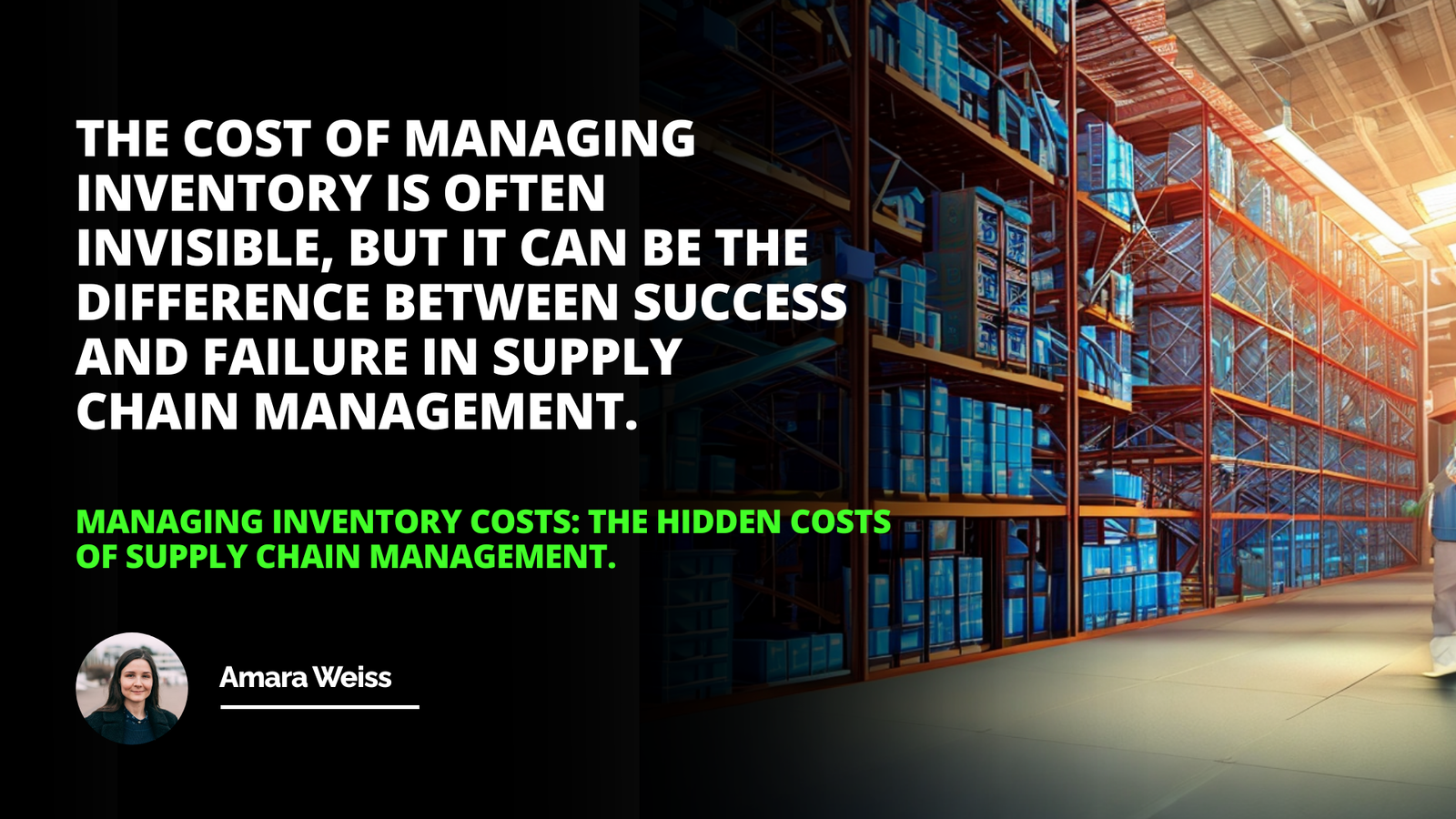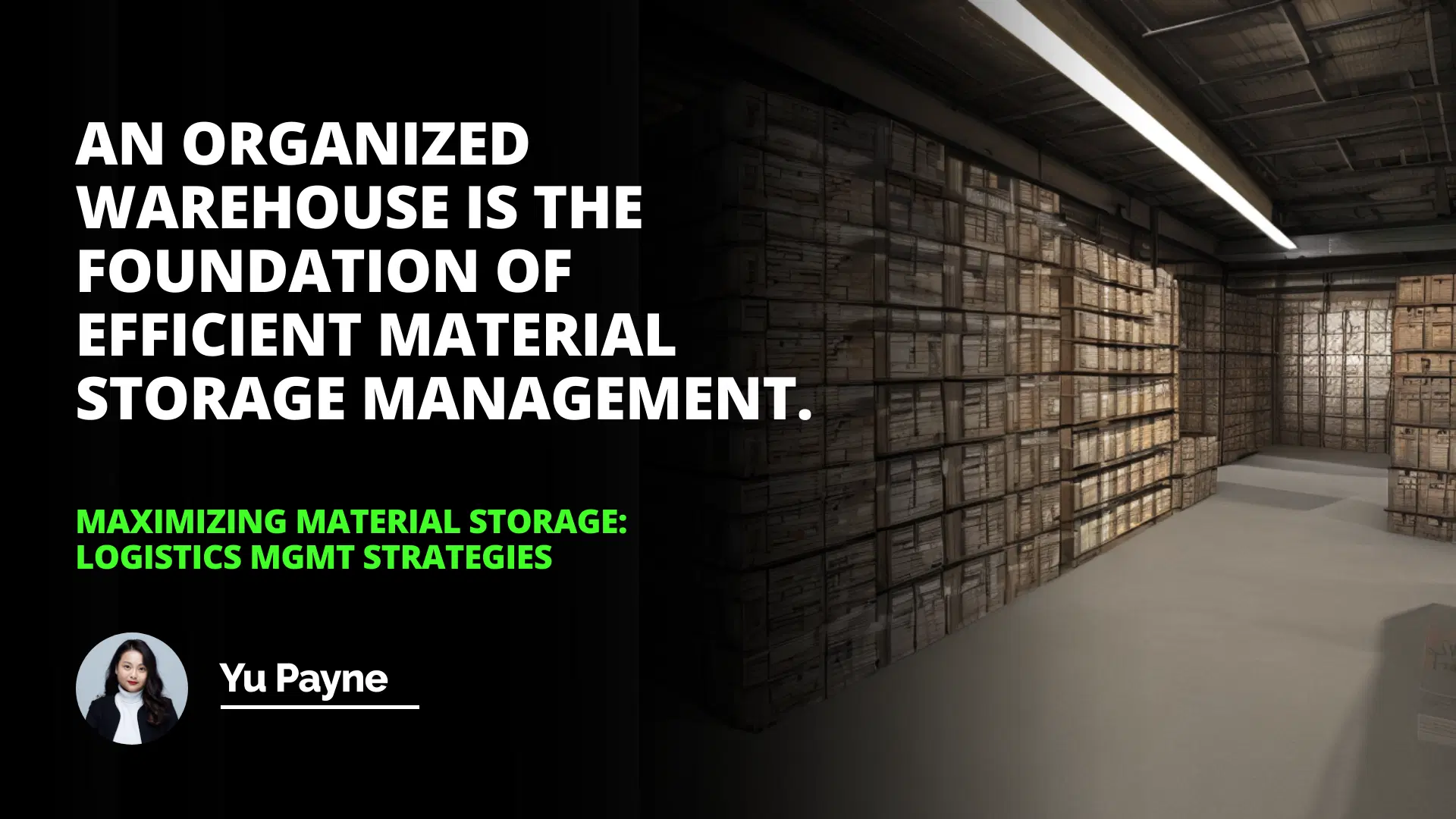
I still remember the first time I walked into my family's warehouse as a child. It was a vast space filled with towering shelves and boxes stacked as high as the eye could see. To my young eyes, it was like a playground of endless adventures. Little did I know that behind that seemingly chaotic maze was a carefully orchestrated system designed to keep the wheels of our family business turning smoothly.
The Importance of Efficient Material Storage
Material storage isn't just about putting things away until they're needed. It's the backbone of any manufacturing or distribution process. An organized warehouse is essential for ensuring that materials are available when needed, reducing costs, and improving overall efficiency.
Introduction
The Function of Material Storage
Logistics Management Strategies
Maximizing Material Storage
Conclusion
Holding: The Warehouse's Primary Function
At its core, a warehouse acts as a holding space for materials and products. Consider a time when a friend of mine, who runs a local manufacturing business, faced severe delays because his supplier couldn't deliver raw materials on time. He realized that by not maintaining adequate inventory levels, his entire production line could come to a grinding halt. By effectively holding materials, businesses can buffer against supply chain uncertainties.
Sorting: Organizing for Efficiency
Imagine trying to find a needle in a haystack. Without proper sorting, that's precisely what retrieving materials from a warehouse can feel like. By organizing materials according to their characteristics—such as size, weight, or type—we make it easier to locate them when the time comes. I recall visiting a warehouse where items were sorted haphazardly. The staff spent more time searching for products than actually moving them. Implementing a proper sorting system transformed their operations overnight.
Consolidating: Making the Most of Space
Space is at a premium in any warehouse. Consolidating similar materials not only saves space but also streamlines operations. Think about stacking similar boxes together or grouping related products. A colleague once shared how they reduced their storage costs by 20% simply by consolidating their inventory more effectively.
Distributing: Getting Materials Where They Need to Be
Finally, the distribution function ensures that materials move from the warehouse to their next destination efficiently. Whether it's shipping products to customers or moving raw materials to the production line, effective distribution minimizes delays and keeps the entire supply chain flowing smoothly.
An In-depth Study of Lean Logistics: Excellence in Supply Chains
Exploring the Dynamics of Multi-modal Transportation in Supply Chain
Decoding the Process and Benefits of Return Merchandise Authorization (RMA)
Logistics Management Strategies
In the world of logistics, order fulfillment reliability in logistics management is paramount. It's not enough to have materials stored; they must be moved and delivered reliably.
Inventory Management: Keeping Track of It All
Effective inventory management is like keeping a well-balanced checkbook. It's essential to know what's in stock, what's running low, and what's overstocked. By maintaining accurate inventory levels, businesses can avoid the pitfalls of stockouts or overstocking. I once assisted a small retailer who was losing money due to excess inventory gathering dust. By implementing a just-in-time inventory system, they freed up cash flow and reduced waste.
Order Processing: The Customer's Journey Begins
Every customer's journey starts with an order. Efficient order processing ensures that orders are accurate, processed quickly, and delivered on time. This enhances customer satisfaction and builds brand loyalty.
Transportation Management: The Road to Success
Transportation management involves planning and optimizing routes, selecting the right carriers, and ensuring timely deliveries. A friend in the logistics industry often emphasizes that "a product isn't sold until it's delivered." Efficient transportation can reduce costs and improve delivery times.
Warehouse Management: The Heart of Operations
At the heart of it all is warehouse management. This encompasses everything from the layout of the warehouse to the technology used to track inventory. By optimizing warehouse operations, businesses can increase efficiency, reduce errors, and improve safety.
Maximizing Material Storage
So, how can businesses make the most of their warehouse space?
Optimizing Warehouse Layout
An efficient warehouse layout minimizes movement and maximizes space utilization. By arranging aisles, shelves, and storage areas strategically, workers can navigate the warehouse more efficiently. I recall helping a company reconfigure their warehouse layout, which reduced their picking time by 30%.
Implementing Automated Systems
Technology is a game-changer in warehouse management. Automated systems, such as Warehouse Management Systems (WMS) and barcode scanning, can significantly reduce errors and improve efficiency. Automated storage and retrieval systems (AS/RS) can handle materials faster and more accurately than manual methods.
An organized warehouse is the foundation of efficient material storage management.
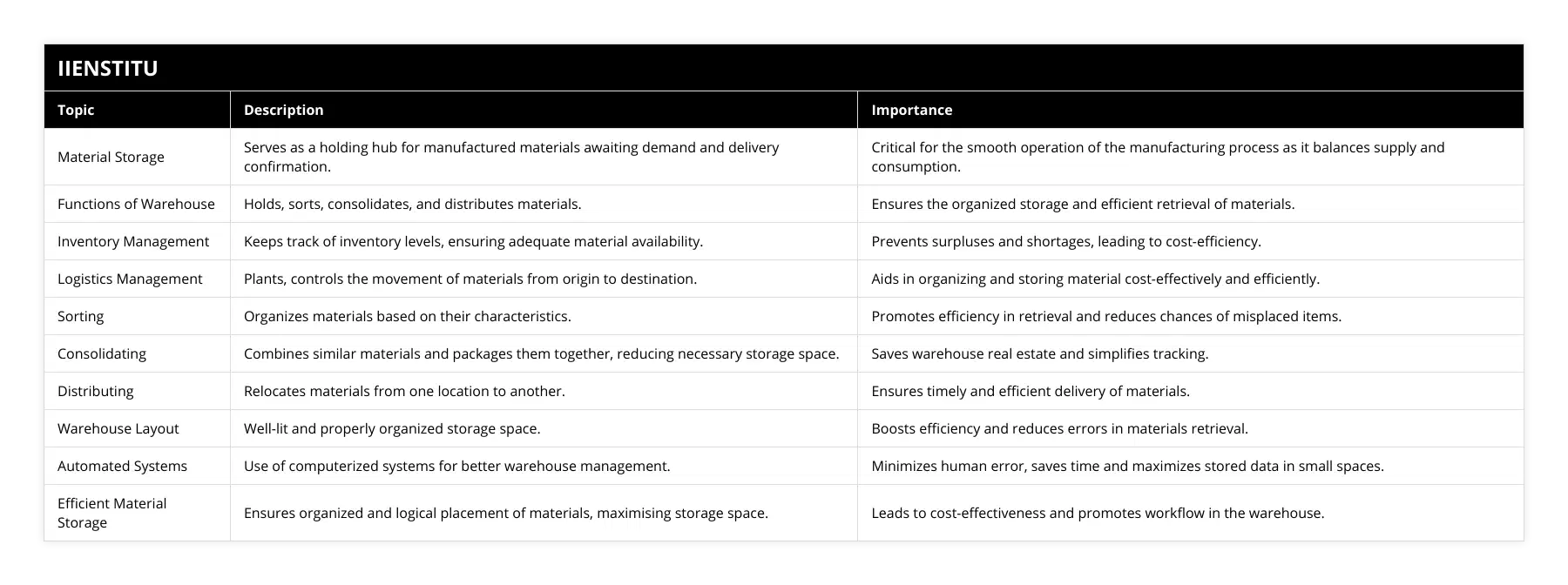
Leveraging Vertical Space
Often, warehouses only utilize floor space, neglecting the vertical space above. By installing taller shelving units and utilizing equipment like forklifts, businesses can maximize the use of vertical space.
Regular Training and Safety Protocols
An organized warehouse isn't just about storage; it's also about the people who work there. Regular training ensures that staff are aware of the best practices and safety protocols, reducing accidents and improving efficiency.
Periodic Inventory Audits
Conducting regular inventory audits helps maintain accurate records, identify discrepancies, and prevent losses. This practice keeps the material storage system running smoothly.
Personal Experiences in Warehouse Management
Over the years, I've had the opportunity to work with various businesses to improve their warehouse operations.
Case Study: Transforming a Chaotic Warehouse
A local electronics distributor was struggling with delayed shipments and lost inventory. Their warehouse was disorganized, with items scattered randomly. Customers were complaining about late deliveries and incorrect orders.
We started by implementing a proper sorting system, organizing products by category and frequency of order. High-demand items were placed closer to the shipping area, reducing the time it took to fulfill orders. We also introduced a basic inventory management system to track stock levels in real-time.
The result? Order accuracy improved by 50%, and order fulfillment reliability in logistics management increased significantly. Customers noticed the difference, and the company saw a boost in repeat business.
Lessons Learned
From these experiences, I've learned that:
1- Organization is key: A well-organized warehouse improves efficiency and reduces errors.
2- Technology aids efficiency: Even simple automation can have a significant impact.
3- Training empowers staff: Knowledgeable staff are more efficient and make fewer mistakes.
4- Safety shouldn't be overlooked: A safe warehouse is a productive warehouse.
5- Continuous improvement is essential: Regular reviews help identify areas for improvement.
The Role of Technology in Modern Warehousing
In today's fast-paced world, technology plays an integral role in optimizing warehouse operations.
Warehouse Management Systems (WMS)
A Warehouse Management System helps manage and control day-to-day operations. It guides inventory receiving and put-away, optimizes picking and shipping orders, and advises on inventory replenishment.
Radio-Frequency Identification (RFID)
RFID tags allow for real-time tracking of inventory without the need for manual scanning. This technology increases accuracy and efficiency in inventory management.
Automated Guided Vehicles (AGVs)
AGVs are robotic vehicles used to transport materials around the warehouse. They reduce the need for manual labor, lower the risk of accidents, and increase productivity.
Environmental Considerations in Material Storage
Sustainability is becoming increasingly important in all aspects of business, including warehousing.
Energy Efficiency
Implementing energy-efficient lighting and climate control systems can reduce the warehouse's environmental footprint and lower operating costs.
Sustainable Materials
Using sustainable packaging materials and recycling programs minimizes waste and supports environmental initiatives.
Optimized Transportation
By planning efficient transportation routes and consolidating shipments, businesses can reduce fuel consumption and emissions.
Conclusion
Material storage is more than just stacking boxes in a warehouse. It's a complex system that requires careful planning, organization, and management. By focusing on key functions like holding, sorting, consolidating, and distributing, and by implementing effective logistics management strategies, businesses can enhance their warehouse operations.
The journey towards an efficient warehouse is ongoing. It involves embracing new technologies, training staff, and continually seeking ways to improve. But the rewards—improved efficiency, reduced costs, and increased customer satisfaction—are well worth the effort.
An organized warehouse is the foundation of efficient material storage management. It's not just about space; it's about creating a system that supports the entire supply chain, from raw materials to the customer's hands.
References
1- Bowersox, D. J., Closs, D. J., & Cooper, M. B. (2013). Supply Chain Logistics Management (4th ed.). McGraw-Hill Education.
2- Richards, G. (2017). Warehouse Management: A Complete Guide to Improving Efficiency and Minimizing Costs in the Modern Warehouse (3rd ed.). Kogan Page Publishers.
3- Frazelle, E. (2002). World-Class Warehousing and Material Handling. McGraw-Hill.
4- Tompkins, J. A., & Smith, J. D. (1998). The Warehouse Management Handbook (2nd ed.). Tompkins Press.
Frequently Asked Questions
What are the key components of a successful logistics management strategy for maximizing material storage?
To maximize the effectiveness of material storage, efficient logistics management is essential. Logistics management involves various activities such as planning, organizing, and controlling the movement of materials and resources. A successful logistics management strategy is critical to optimizing material storage and ensuring that the materials are stored most efficiently and cost-effectively. This article will discuss the essential components of a successful logistics management strategy for maximizing material storage.
The first component of a successful logistics management strategy is effective inventory management. Inventory management tracks and controls the flow of materials and resources within an organization. This includes monitoring the fabric in stock, determining the optimum quantity of materials to be stored, and ensuring timely delivery. By effectively managing inventory levels, the organization can ensure that only the necessary materials are stored and stored most efficiently.
The second component of a successful logistics management strategy is efficient transportation. Transportation management involves the planning and management of the transportation of materials from one location to another. This includes the selection of a suitable mode of transport, the scheduling of delivery times, and the tracking of shipments. As a result, transportation management ensures that materials are transported in the most cost-effective and timely manner and stored most efficiently.
The third component of a successful logistics management strategy is effective warehouse management. Warehouse management involves the planning and managing of the storage of materials in warehouses. This includes the selection of an appropriate warehouse location, the organization of the storage space, and the tracking of materials in the warehouse. Warehouse management ensures that materials are stored most efficiently, that they are stored safely, and that they are accessible when needed.
Finally, the fourth component of a successful logistics management strategy is practical to supply chain management. Supply chain management involves planning and managing the movement of materials and resources from supplier to customer. This includes the selection of suppliers, the negotiation of prices, and the tracking of shipments. As a result, supply chain management ensures that materials are purchased cost-effectively and delivered to the customer promptly.
In conclusion, effective logistics management is essential for optimizing material storage. The critical components of a successful logistics management strategy for maximizing material storage include effective inventory management, transportation, warehouse management, and supply chain management. By following these components, organizations can ensure that materials are stored most efficiently and cost-effectively.
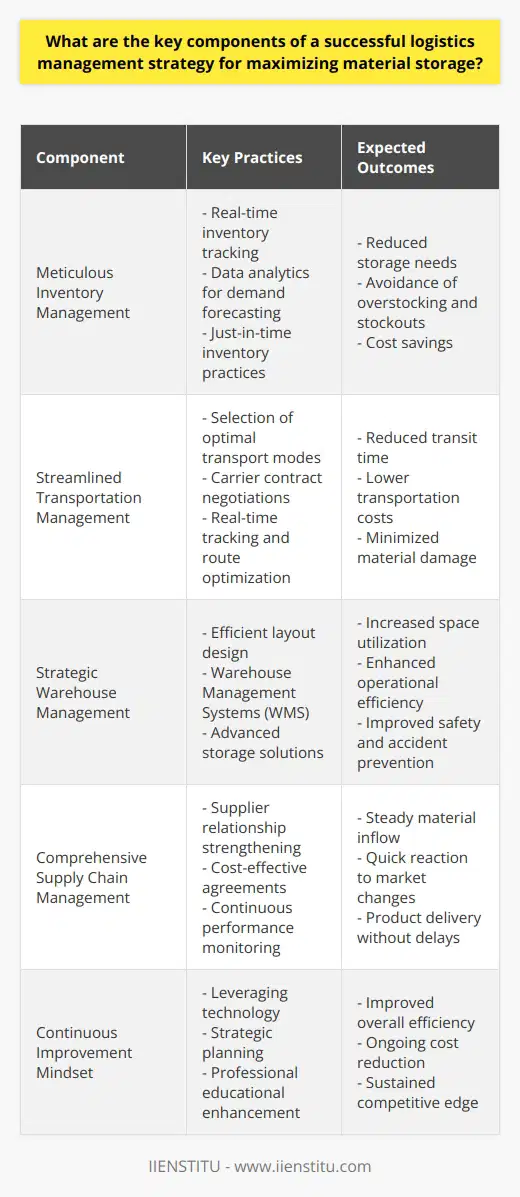
How can businesses ensure that their material storage is optimized for efficiency and cost-effectiveness?
Businesses must be mindful of their material storage strategies, as they play an essential role in the efficiency and cost-effectiveness of operations. Companies need to optimize their material storage to ensure the best use of their resources.
The first step to ensuring efficient and cost-effective storage is identifying the materials used most frequently. This allows businesses to prioritize the storage of these items and determine the best locations for them. For example, materials used more often should be placed closer to the point of use, while those used less frequently can be stored further away. Additionally, businesses can take advantage of existing space by utilizing vertical and overhead storage.
Businesses should also consider the packaging of their materials. Packaging and palletization can help reduce transportation costs and improve inventory control. Also, proper packaging can help with storage, as it can maximize space and reduce the number of required handling steps.
In addition, businesses should consider the use of automated storage systems. Automated storage systems can help reduce labor costs, improve accuracy, and increase efficiency. Computerized systems can also help businesses keep track of inventory levels and improve safety by eliminating manual handling.
Finally, businesses should ensure that their material storage is secure. This is especially important for items that are valuable or sensitive. Security measures such as locked storage, cameras, and alarm systems can help protect materials and reduce the risk of theft or damage.
Overall, businesses must ensure that their material storage is optimized for efficiency and cost-effectiveness. This can be achieved by identifying frequently used materials, utilizing existing space, considering packaging and palletization, utilizing automated storage systems, and ensuring security. By following these steps, businesses can ensure that their material storage is optimized, helping to increase efficiency and cost-effectiveness.

What are the potential benefits of implementing a comprehensive logistics management strategy for material storage?
In recent years, the importance of efficient logistics management strategies for material storage has become increasingly evident. The advantages of implementing a comprehensive logistics management strategy for material storage include improved efficiency, reduced costs, and improved customer service.
Firstly, implementing a comprehensive logistics management strategy for material storage can improve efficiency by streamlining the storage process. Companies can automate the storage process by utilizing advanced technology such as warehouse management systems (WMS) and enterprise resource planning (ERP) systems, ensuring that materials are stored most efficiently. Additionally, by real-time inventory tracking, companies can ensure that materials are stored correctly, and that inventory levels are maintained. This can help to reduce the time and effort required to store and access materials, resulting in improved efficiency.
Secondly, implementing a comprehensive logistics management strategy for material storage can result in cost savings. By utilizing advanced technology, companies can reduce the need for manual labor and the costs associated with storage. Additionally, by optimizing inventory levels, companies can reduce the amount of overstocking and understocking, resulting in reduced inventory costs.
Finally, implementing a comprehensive logistics management strategy for material storage can improve customer service. By utilizing advanced technology, companies can ensure that suitable materials are available at the right time, resulting in improved customer satisfaction. Additionally, by utilizing real-time inventory tracking, companies can provide accurate inventory levels, ensuring that customers can make informed purchasing decisions.
In conclusion, implementing a comprehensive logistics management strategy for material storage can offer several potential benefits, including improved efficiency, cost savings, and customer service. Companies looking to improve their storage processes should consider investing in a comprehensive logistics management strategy. By utilizing advanced technology, companies can ensure that their storage processes are efficient and cost-effective, resulting in improved customer satisfaction.
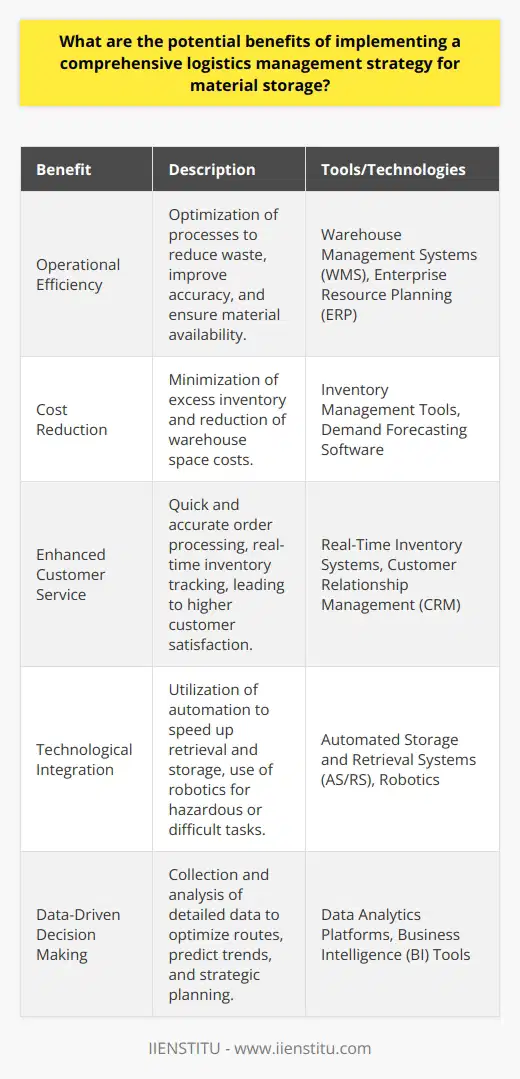
What are the essential principles for designing an effective storage management system in logistics?
Etkili Bir Depolama Yönetim Sistemi Tasarımında Esas Prensipler
Depolama Alanının Optimize Edilmesi
Lojistikte etkili bir depolama yönetim sistemi tasarlamada ilk adım, depolama alanını optimize etmektir. Depo alanının verimli kullanılması, hem maliyetleri düşürür hem de lojistik süreçlerin hızlanmasına yardımcı olur. Bu amaçla, yüksek yoğunluklu raf sistemleri veya modüler yapılar kullanılabilir.
Entegrasyon ve Standartlaştırma
Başarılı bir depolama yönetim sistemi, tüm lojistik süreçleriyle uyumlu çalışmalıdır. Sistem entegrasyonu, süreçlerin etkinliğini artırır ve bilgi paylaşımını sağlar. Bu nedenle, lojistik hizmet sağlayıcılarının ve tedarikçilerin iletişim kurabileceği standartlara uygun bir entegrasyon stratejisi geliştirilmelidir.
Yüksek Otomasyon Seviyesi
Etkili bir depolama yönetim sistemi, insan iş gücüne dayalı hataları ve zaman kayıplarını önlemek için yüksek düzeyde otomasyon sağlamalıdır. Gelişmiş çözümler, satın almadan teslimata kadar süreçlerin kesintisiz ve hızlı olmasını sağlar. Bu, özellikle büyük depo sistemlerinde önemli avantajlar sunar.
Esneklik ve Ölçeklenebilirlik
Lojistik süreçlerin ve talep paternlerinin değişebilir doğası göz önünde bulundurulduğunda, etkili bir depolama yönetim sistemi, esnek ve ölçeklenebilir olmalıdır. Şirketlerin büyüme ve değişen pazar koşullarına uyum sağlamalarına imkan tanıyan bir yapı, lojistik süreçlerin etkin ve sürdürülebilir olmasını sağlar.
Veri Toplama ve Analizi
Etkili bir depolama yönetim sistemi, lojistik süreçlere ait detaylı veriler toplamalı ve analiz etmelidir. Veri analizi, süreçlerin optimize edilmesine ve hataların tespit edilerek giderilmesine olanak sağlar. Bu yaklaşım, sürekli iyileştirme anlayışıyla uyumludur ve işletmelere maliyet avantajı sağlar.
Sonuç olarak, etkili bir depolama yönetim sistemi tasarlarken, depolama alanının optimize edilmesi, entegrasyon ve standartlaştırma, yüksek otomasyon seviyesi, esneklik ve ölçeklenebilirlik ve veri toplama ve analizi gibi prensipler dikkate alınmalıdır. Bu sayede, lojistik süreçler daha verimli ve maliyet etkin hale gelir.
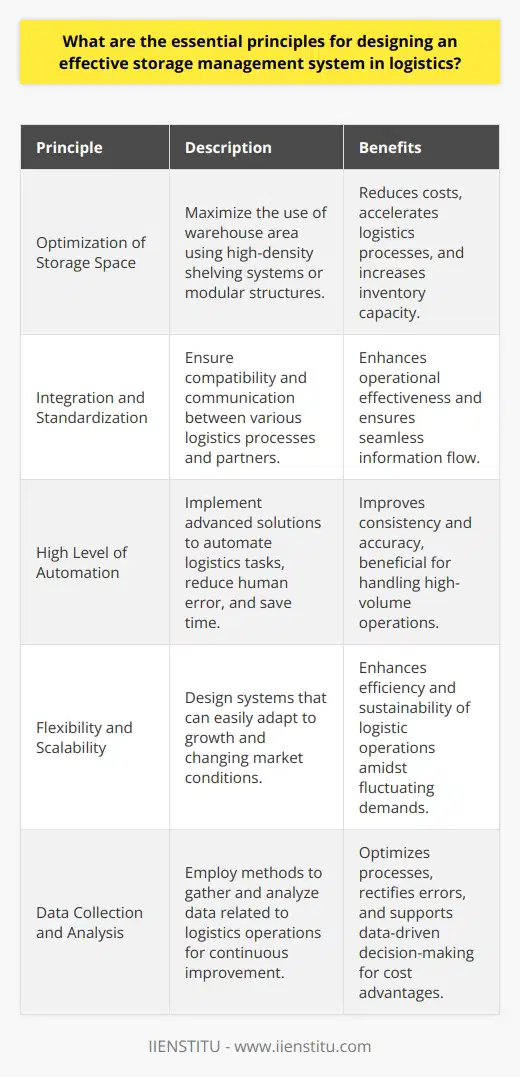
How do warehouse layout and organization contribute to efficient material management in logistics?
Depo Düzeni ve Organizasyonun Etkisi
Lojistik sektöründe malzeme yönetiminin verimliliği, depo düzeni ve organizasyonu ile yakından bağlantılıdır. İyi planlanmış bir depo düzeni, malzeme hareketini hızlandırırken, verimli bir organizasyon süreçleri ve iş gücünü en iyi şekilde yönlendirir.
Deponun Fiziksel Yapısı
Depo düzeni, yönetimin seçtiği depolama yöntemleri ve ekipmanlarla desteklenen deponun fiziksel yapısıdır. Malzemelerin düzgün bir şekilde sınıflandırılması, yönlendirilmesi ve saklanması, lojistik süreçlerinin verimli şekilde sonuçlanmasında önemlidir.
Raflar ve Depolama Alanları
Depo içerisinde doğru raflar ve depolama alanlarının kullanılması, malzemelerin yerleştirilmesi ve çıkarılması sırasında verimlilik sağlar. Ayrıca, dar alanlarda bile maksimum depolama kapasitesini kullanarak, depo alanının en verimli şekilde değerlendirilmesine olanak tanır.
Kullanılan Ekipmanlar
Malzemelerin taşınmasında kullanılan ekipmanlar, depo düzeni ve organizasyonunun etkinliğini artırır. Hızlı ve güvenli malzeme hareketini sağlayan ekipmanlar, süreçlerin hızlanmasına ve depo genelindeki verimliliğin artmasına katkı sağlar.
Bilgi Yönetimi
Depo düzeninin yanı sıra, etkili bir bilgi yönetimi sistemi, malzeme yönetiminin verimliliğini önemli ölçüde artırır. Bilgi yönetimi sayesinde, malzeme giriş ve çıkışları, envanter seviyeleri ve süreçlerle ilgili doğru bilgiler sürekli takip edilebilir ve yönetilebilir.
Emek Yönetimi
Depo organizasyonu, emek yönetiminin doğru şekilde yapılmasını gerektirir. İşçi ve yöneticilerin görevlendirilmesi, eğitimi ve yetkinliklerinin değerlendirilmesi, malzeme yönetiminin verimliliğini ve süreçlerin hızını etkiler.
Sonuç olarak, depo düzeni ve organizasyonu, malzeme yönetimi süreçlerinin verimliliğinde önemli bir rol oynar. Depo içinde kullanılan ekipmanlar, raflar ve depolama alanları ile bilgi ve emek yönetimi, lojistik süreçlerin etkinliğini ve maliyet düşürmede katkı sağlar.
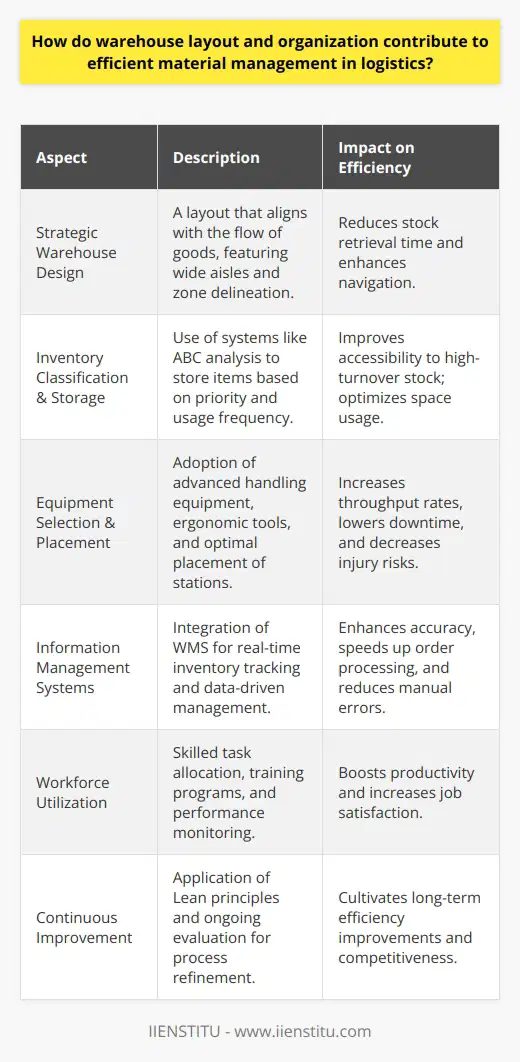
What role do technology and automation play in optimizing material handling and storage within the logistics industry?
Teknoloji ve Otomasyonun Etkisi
Lojistik sektöründe malzeme taşıma ve depolama optimizasyonu, teknoloji ve otomasyon ile önemli ölçüde gelişmektedir. Otomasyon sistemleri, verimliliği artıran ve maliyetleri düşüren önemli bir faktördür.
Yük Taşıma ve Paketleme
Bu süreçler, konveyör sistemleri, robotik manipülatörler ve otomatik paketleme makineleri gibi otomatik ekipmanlarla optimize edilmiştir. Bu sistemler, hızlı ve kesin hareketlerle malzemeleri taşır ve paketler, böylece insan hatası riskini azaltır ve üretkenliği artırır.
Stok Yönetimi ve Envanter
Otomasyon, stok ve envanter yönetimi için barındırdığı teknolojilerle ilerlemiştir. RFID etiketleri, barkod okuyucular ve sensörler, gerçek zamanlı envanter bilgileri sağlar, bu da lojistik şirketleri için doğru stok seviyelerini sürdürmeyi mümkün kılar. Bu süreçler, hatasız ve daha hızlı karar vermeyi destekler.
Depo Yönetimi ve İşlemleri
Depo yönetimi yazılımları (WMS), iş akışlarını ve depo alanı kullanımını optimize etmek için kullanılır. Ayrıca, gerçek zamanlı verilere dayalı talep tahminleri ve sipariş yönetimi gibi daha verimli işlemleri destekler. Otomatik depolama ve geri çağırma sistemleri (AS/RS) de depolama sürelerini ve personel maliyetlerini düşürür.
Taşıma ve Dağıtım
Lojistik sektöründe teknoloji ve otomasyon, taşıma ve dağıtım süreçlerini de geliştirmiştir. Gelişmiş rota planlama yazılımları, taşıma sürelerini ve yakıt maliyetlerini düşüren en uygun yolları önerebilir. Ayrıca, telematik sistemler, filo verimliliğini artırmak ve güvenliği sağlamak için kullanılabilir.
Sonuç Olarak
İş süreçlerinde teknoloji ve otomasyon entegrasyonu, lojistik endüstrisinde malzeme taşıma ve depolama optimizasyonunu önemli ölçüde etkilemektedir. İşletmeler, verimlilik ve maliyet tasarrufu sağlamak amacıyla bu teknolojik gelişmeleri kullanarak rekabet avantajı elde edebilir.
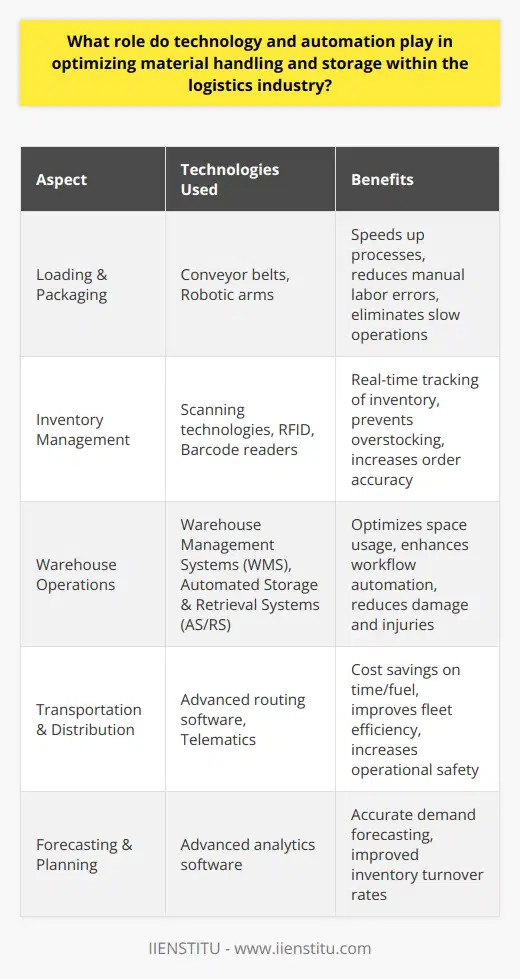
What are the main factors influencing optimal warehouse location selection in logistics operations?
Factors in Warehouse Location Selection
A variety of factors must be considered when selecting the optimal warehouse location for logistics operations. The most critical factors include proximity to customers, transportation accessibility, labor availability, community infrastructure, and cost effectiveness.
Proximity to Customers
An optimal warehouse location should be close to the target customer base, facilitating efficient and timely delivery of goods. This not only reduces transportation costs but also ensures customer satisfaction by shortening delivery times.
Transportation Accessibility
Easy access to different modes of transportation is crucial for a successful logistics operation. Warehouses should ideally be located near highways, railway lines, seaports, or airports to ensure convenient and efficient movement of goods between locations, whether regional or international destinations.
Labor Availability
A sufficient and skilled workforce is essential for smooth warehouse operations. Therefore, selecting an area with an abundant labor force helps ensure operational efficiency. Moreover, considering labor cost plays a significant role in maintaining overall cost efficiency, and warehouse location can significantly impact pay rates.
Community Infrastructure
The area surrounding the warehouse should have a well-developed infrastructure, including utilities, communications, and local amenities. This factor is critical not only for the smooth functioning of warehouse operations but also for attracting and retaining a skilled workforce.
Cost Effectiveness
Lastly, cost effectiveness is a primary consideration in warehouse location selection. This includes land and construction costs, property taxes, utility expenses, and transportation costs. Ultimately, finding a location that balances these costs while maintaining optimal operations should be the main goal.
In conclusion, the optimal warehouse location for logistics operations is influenced by factors such as proximity to customers, transportation accessibility, labor availability, community infrastructure, and cost effectiveness. A comprehensive evaluation of these factors can help businesses decide on the most suitable and strategic location for their warehousing needs, ensuring overall efficiency and success.

How do transportation and distribution networks contribute to the overall efficiency of logistics management strategies?
Efficiency of Transport and Distribution Networks
Transportation and distribution networks play a critical role in enhancing the overall efficiency of logistics management strategies by streamlining the movement of goods from one location to another. These networks allow organizations to ensure timely delivery of goods, reduce operating costs, and improve customer satisfaction.
Reduction in Operating Costs
An effective transportation network enables companies to reduce operating costs by optimizing fuel consumption and vehicle maintenance costs. Moreover, proper route planning and vehicle utilization can lead to further savings. Similarly, modern distribution networks incorporate automation technologies that enable efficient management of inventory and warehousing costs.
Improved Customer Satisfaction
Implementing efficient transportation and distribution networks allows businesses to promptly deliver products to customers, leading to improved satisfaction. By employing real-time tracking and reporting technologies, companies can maintain transparency throughout the supply chain and enhance customer trust.
Automation and Technology Integration
Integration of advanced technologies such as robotics, artificial intelligence, and the Internet of Things (IoT) has transformed transportation and distribution networks. These technologies enable businesses to optimize route planning, track shipments in real-time, and automate inventory management – all contributing to the overall efficiency of logistics management strategies.
Sustainable Logistics Practices
Transportation and distribution networks also contribute to the adoption of sustainable logistics practices through an emphasis on eco-friendly vehicles, energy-efficient warehouses, and reduction of waste. These practices not only result in cost-savings for the companies but also reduce the environmental impact of logistics operations.
In conclusion, transportation and distribution networks significantly contribute to the overall efficiency of logistics management strategies by enabling cost reduction, improving customer satisfaction, promoting automation and technology integration, and supporting sustainable practices. By investing in these networks, organizations can achieve long-term success and remain competitive in an increasingly complex logistics landscape.

In what ways can companies leverage data analytics and key performance indicators to improve the effectiveness of their logistics operations?
Leveraging Data Analytics in Logistics Operations
To improve the effectiveness of logistics operations, companies can leverage data analytics in various ways, including demand forecasting, route optimization, and performance evaluation. By employing data analytics, businesses obtain critical insights into their supply chain processes, enabling them to make data-driven decisions and better serve their customers.
Enhancing Demand Forecasting
Firstly, one of the most significant aspects of logistics operations for any company is demand forecasting. Accurate demand forecasting enables businesses to maintain suitable inventory levels, reduce stockouts, and minimize holding costs. Data analytics tools can collect and analyze large amounts of historical sales data, seasonal trends, and market indicators, facilitating accurate predictions of customer demand. By enhancing demand forecasting, companies can optimize their inventory management, leading to improved efficiency and reduced costs.
Optimizing Route Planning
Another way companies can leverage data analytics is by optimizing route planning. With increasing fuel prices, traffic congestions and transport costs, efficient route planning has become vital for reducing delivery times and costs. Data analytics tools can analyze traffic patterns, weather data, and historical delivery records, allowing companies to design the most efficient delivery routes. Consequently, such route optimization not only saves time and fuel costs but also leads to enhanced customer satisfaction due to shorter delivery times.
Monitoring Key Performance Indicators
Moreover, monitoring Key Performance Indicators (KPIs) is crucial in identifying areas for improvement and tracking the effectiveness of implemented changes in logistics operations. Data analytics can help companies monitor KPIs such as delivery time, costs, inventory turnover, and customer satisfaction. By continuously monitoring these metrics, businesses can quickly identify areas of inefficiency, take corrective actions, and measure the impact of their interventions.
Automating Decision-Making Processes
Lastly, data analytics can aid companies in automating decision-making processes within their logistics operations. By combining machine learning algorithms with real-time data streams, companies can develop advanced analytics systems that notify them of potential issues, such as inventory shortages or transport delays. These automated systems enable companies to respond more quickly and effectively to such issues, reducing operational risks and ensuring seamless supply chain operations.
Conclusion
In summary, companies can leverage data analytics and KPIs to improve the effectiveness of their logistics operations by enhancing demand forecasting, optimizing route planning, monitoring performance metrics, and automating decision-making processes. By incorporating data analytics into their operational strategies, businesses can boost efficiency, reduce costs, and ultimately gain a competitive edge in the increasingly complex global logistics landscape.
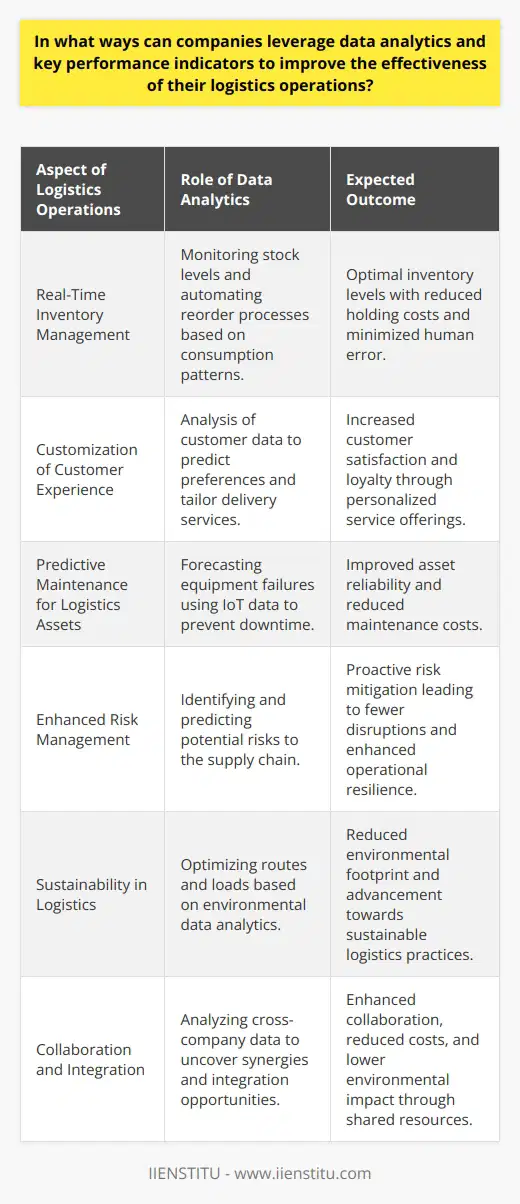
What are the 5 logistics strategies?
Logistics Strategy 1: Warehouse Efficiency
A fundamental logistics strategy involves enhancing warehouse efficiency. Warehouse efficiency speaks to the ability to expedite the movement of goods and services in an organized and systematic manner. This strategy involves processes like labeling, racking, and using warehouse management systems.
Logistics Strategy 2: Supplier Relationship Management
Effective supplier relationship management is another crucial strategy. This involves creating strong relationships with suppliers, which ultimately drives business success. It may include elements such as supplier selection, contract negotiation, and performance monitoring.
Logistics Strategy 3: Thorough Demand Forecasting
Demand forecasting is an essential logistics strategy; it predicts the flow and demand of goods. By analyzing and predicting consumer behavior, businesses can manage their inventory more effectively.
Logistics Strategy 4: Effective Transportation Management
Efficient transportation management is another viable strategy. It includes selecting suitable transportation modes, routes and carriers, with the aim of minimizing costs and maximizing efficiency.
Logistics Strategy 5: Adaptability and Resilience
Finally, the ability to adapt to changing circumstances and to recover swiftly from possible disruptions is a crucial logistics strategy. This encompasses factors like tracking global trends, adopting new technologies, and maintaining a flexible business model.
In conclusion, these five strategies - warehouse efficiency, supplier relationship management, thorough demand forecasting, effective transportation management, and adaptability and resilience - form the backbone of effective logistics management. By adopting and combining these strategies, businesses can achieve superior efficiency and resilience in their logistics operations.
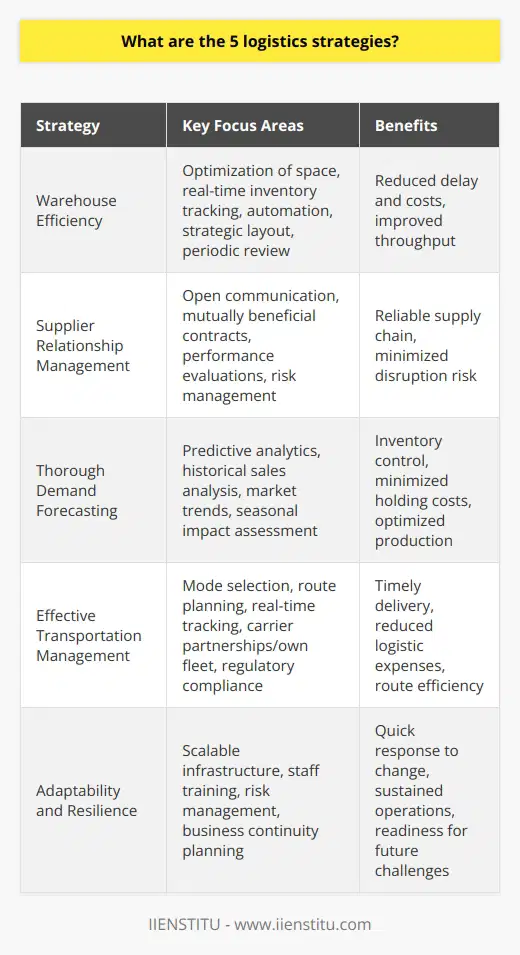
What is strategic storage in logistics management?
Understanding Strategic Storage in Logistics
Strategic storage refers to a planned approach to storing goods within a logistics system. This careful planning aims to help organizations maximize efficiency while reducing costs. It involves the smart positioning of items in a warehouse or distribution center to improve accessibility, streamline operations, and facilitate fast turnaround times.
Role of Strategic Storage
In logistics management, strategic storage serves a crucial role. It helps to maintain a balance between supply and demand, preventing stockouts and overstocks. By doing so, it aids in inventory control and reduces holding costs. Plus, it minimizes the likelihood of items becoming obsolete or reaching their expiration date unnoticed.
Components of Strategic Storage
Key elements of strategic storage include warehousing, distribution, and inventory management. Warehousing involves proper organization of goods in a storage facility. Distribution focuses on the efficient delivery of these goods to the desired destination. Inventory management keeps tabs on the amount and value of products stored.
Strategic Storage Techniques
Various techniques are available for strategic storage. Each organization needs to choose the most suitable method based on its unique requirements. These techniques include cross-docking, drop-shipping, and bulk stacking. Cross-docking can eliminate the need for space-consuming warehouse storage. Drop-shipping can deliver items directly from the manufacturer to the buyer. Bulk stacking can save space in a warehouse.
In conclusion, strategic storage is a fundamental aspect of logistics management. It can create efficiency, reduce costs, and improve customer satisfaction. A well-implemented strategic storage system can give a company a competitive edge in today's cutthroat business environment.

How do I maximize my warehouse storage space?
Understanding Spatial Layout
To maximize warehouse storage space, begin by understanding the spatial layout. Assess the floor area and height to determine storage capacity.
Optimizing Rack Arrangement
Consider optimizing rack arrangement by using high-density storage such as pallet racks or mobile shelving systems. These improve space utility and accessibility.
Using Vertical Space
Vertical space is typically underutilized in many warehouses. Use tall storage units and stack items high with proper safety measures.
Implementing FIFO System
Implement a FIFO (First In, First Out) system. This ensures goods don't sit for long, and improves space management.
Lean Inventory Management
Practice lean inventory management. Only store what you need to reduce unnecessary clutter.
Automating Warehouse Processes
Automation can improve storage density. Automated Storage and Retrieval Systems (AS/RS) use less space and increase efficiency.
Investing in Warehouse Management Software
Invest in warehouse management software. This allows for better organization and tracking, enabling effective space usage.
Improving Staff Training
Finally, proper staff training is crucial. Educated staff understand how to efficiently use space and maintain an organized warehouse.
By integrating these measures, one can significantly enhance the use of existing warehouse space. This not only increases storage capacity but also enhances operational efficiency and productivity.


